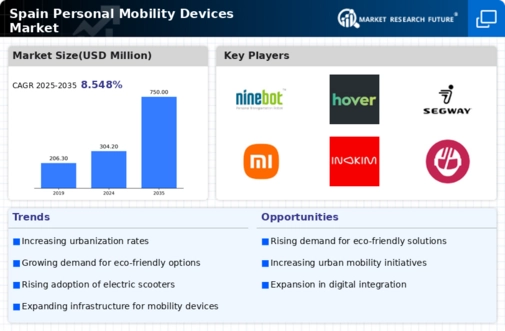The competitive insights of the Spain Personal Mobility Devices Market reveal a dynamic landscape characterized by rapid technological advancements and shifting consumer preferences towards eco-friendly and efficient mobility solutions. This market is experiencing significant growth fueled by urbanization, rising environmental concerns, and the increasing popularity of alternatives to traditional transportation methods. Various players in the market are continually innovating to meet the diverse needs of consumers, establishing a competitive environment that encourages differentiation and specialization among personal mobility devices such as electric scooters, hoverboards, and electric bikes.
With government initiatives supporting green transportation and the integration of smart technology into mobility devices, the landscape is attracting both established players and new entrants striving to capture market share.In Spain, Ninebot has established a robust presence within the personal mobility devices market, leveraging its innovative technology and quality manufacturing. The company has rolled out a wide range of products, including scooters and electric bikes, which cater to urban commuters seeking reliable and efficient transportation options. Ninebot's products are renowned for their robustness, advanced battery technology, and appealing design, making them a popular choice among consumers.
The brand also enjoys a strong reputation for customer service and support, further solidifying its position in the competitive market. Additionally, collaboration with local retailers and marketing campaigns tailored to the Spanish customer base have amplified Ninebot's visibility, allowing it to capture a significant share of the growing market.Hover1 has made notable headway in the Spain Personal Mobility Devices Market with a diverse range of personal mobility solutions that include electric scooters, hoverboards, and e-bikes. The company’s strengths lie in its commitment to quality and safety, which resonate well with Spanish consumers who prioritize these attributes in their purchases.
Hover1 focuses on creating products that are not only user-friendly but also technologically advanced, featuring smart connectivity and robust battery life. The brand's strategic partnerships and effective distribution channels enhance its market presence, allowing for widespread reach across various retail outlets in Spain. Hover1 emphasizes continuous innovation, keeping pace with market demands through the introduction of new models and design upgrades. Acquisitions and collaborations enable Hover1 to expand its portfolio and enhance technological capabilities, further strengthening its foothold in Spain’s competitive landscape for personal mobility devices.




















